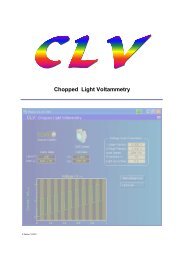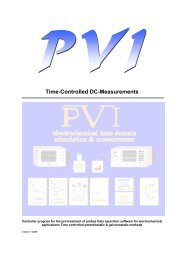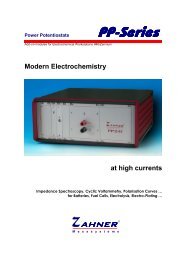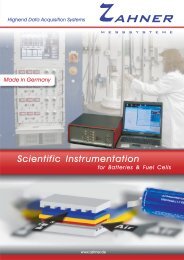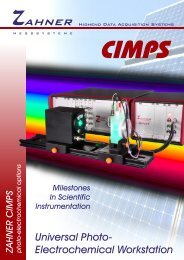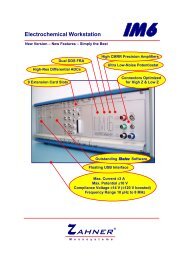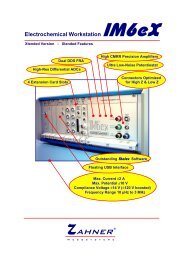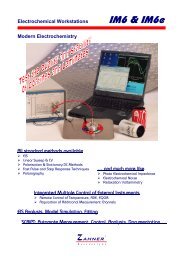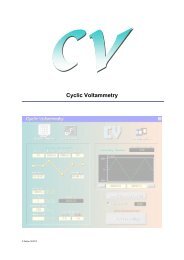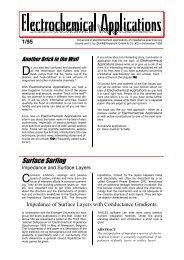Electrochemical Workstation - ZAHNER-elektrik GmbH & Co. KG
Electrochemical Workstation - ZAHNER-elektrik GmbH & Co. KG
Electrochemical Workstation - ZAHNER-elektrik GmbH & Co. KG
You also want an ePaper? Increase the reach of your titles
YUMPU automatically turns print PDFs into web optimized ePapers that Google loves.
Highend Data Acquisition SystemsM E S S S Y S T E M ECIMPS<strong>ZAHNER</strong> CIMPSphoto-electrochemical optionsMilestonesIn ScientificInstrumentationUniversal Photo-<strong>Electrochemical</strong> <strong>Workstation</strong>
<strong>ZAHNER</strong> CIMPSphoto-electrochemical optionsGeneralCIMPS is a photo-electrochemical research system for a wide field of applications. It is based on our universalelectrochemical workstations Zennium or IM6, extended by special hard- and software. The basic configuration wasdesigned with focus on static and dynamic photo-electrochemical transfer function measurement, popular in the research ofalternative solar cell concepts. In particular, the dynamic transfer functions between photovoltage or photocurrent and lightintensity are relevant for efficiency considerations of dye-sensitized oxide solar cells andorganic solar cells. These functions are known as 'Intensity Modulated PhotocurrentSpectroscopy' IMPS and 'Intensity Modulated Photo-Voltage Spectroscopy' IMVS.Usually one is interested in the dominating time constants found by IMVS at open circuitconditions and by IMPS at short circuit conditions. Beyond this, thorough analysis andsimulation of the transfer functions in combination with EIS can give deep insights into the cellunder test and the working mechanisms in detail.IMPS and IMVS are determined in the frequency domain by means of a light source, which ismodulated in intensity over a broad frequency range, analogous to the EIS principle. CIMPSuses light emitting diodes 'LED' for that purpose. Different from a laser, LED do not need highmodulation energy, and artifacts due to the presence of high voltage close to smallmeasurement signals can be avoided. There is also no need for expander lenses, whichmust be inserted into a laser beam to illuminate electrodes havingtypical areas of up to several square centimetres.CIMPS is the first complete system on the market designed especially forthat purpose. <strong>Co</strong>mpared to the IMPS described in elder literature,important improvements were made by Zahner: a control loopregulates light intensity and modulation keeping it absolutely stable.The automatic comparison between set value and sensed intensityeliminates the influence of non-linearity, ageing and temperature drift.Instead of the LED supply current, used as a substitute magnitude in thetraditional set-up, the actually measured intensity is fed into the transferfunction calculation, avoiding scale- and phase shift errors. As anadditional advantage, CIMPS allows the automatic calibration of theillumination in natural units of intensity (W/m2), providing instantquantum efficiency information. Therefore Zahner light sources are shipped with NIST traceable calibration. A certificate isavailable on demand. Third party light sources can be calibrated on site with an optional NIST traceable photodetector.A set of supporting functions accompanies the IMPS and IMVS feature, useful forsolar cell analysis as well. The static DC-photo-voltage and photocurrent vs.intensity characteristic can be determined. Among other value, the staticbehaviour provides useful criterions on the relevance of the time constants,derived by IMPS / IMVS. Stability and degradation of a SC may be controlled byrecording photo-voltage and photocurrent vs. time at a constant intensity. SCefficiency, fill factor and maximum power determination is implemented as astandard push button function, which works together with a 3rd-party AM1.5 solarsimulator as well.While IMPS / IMVS are typical small signal linear frequency domain techniques.CIMPS also provides light transient experiments. They can be used in order to crosscheckthe frequency domain results in the time domain, but may cover also thenon-linear regimes.The CIMPS standard package consists of all components necessary for the coreapplication. Due to the individual requirements of the user, light sources have to beordered separately. Please ask for our latest list of LED arrays available in a wide range ofwavelengths and for tuneable light sources.The Zahner PECC cells are optimized for perfect optical as well as electrical characteristicsand come with an Ag/AgCl reference electrode and a Pt counter electrode coil. ThePTFE/PCTFE-based solid allows working in aggressive and non-aqueous electrolytes. A gastightversion, allowing oxygen-free working is available. 'Wet' experiments, for instance halfcellmeasurements, can be performed perfectly in these specially designed photoelectrochemicalcells.Apart from the core application, the CIMPS system may be extended to many otherrelated methods by optional available peripherals. Certain 3rd-party spectrometers can
<strong>ZAHNER</strong> CIMPSphoto-electrochemical optionsbe connected directly. CIMPS is able to control these spectrometers and provides spectral resolved lightemission (OPV)measurements, valuable for instance in OLED research and testing. The CIMPS-abs option may be used for spectralresolved absorption measurements, necessary for the investigation of electro-chromic processes and materials forelectronic displays.Finally, the FRA of the CIMPS system can be configured to a lock-in mode, which allows CIMPS to work together with 3rdpartychopper / monochromator units. This feature opens the door to traditional photocurrent-spectroscopy PCS and thewhole set of related spectro-electrochemical techniques.The components of the CIMPS package are working together in a plug & play application,including the software and an overall calibration of the system. An <strong>Electrochemical</strong><strong>Workstation</strong> (ECW) IM6 or Zennium operates as a Frequency Response Analyser and as asupport unit (Potentiostat / Galvanostat) for the cell under test. The Zahner ECWs arerenowned for their high precision, ease of use and comprehensive software. One mayselect between two slave potentiostats (XPOT, PP211) used for the control of the lightsource, which differ in the output power to cover low-noise as well as in the high intensityapplications.The light source carrier including a high precision low noise photo-amplifier is positioned onan optical bench face to face with the photo-electrochemical cell. A photodiode sensor ismounted close to the cell's light inlet.Intensity / % CIMPS light source WLL01 #0310PeakInt: 19.7%Peak: 448nm1Intensity / % CIMPS light source RTL01 #03195.5PeakInt: 58.1%5 0.8 637nmPeak:Dominant: 635.4nm4.50.64Dominant: 533.6nm3.50.432.5Halfwidth: 200nm0.2Halfwidth: 17.1nm21.5010.5400 450 500 550 600 650 700 750λ / nm0-0.5590 600 610 620 630 640 650 660 670λ / nm
<strong>ZAHNER</strong> CIMPSphoto-electrochemical optionsFunctionsStandard Solar Cell Tests• maximum power• fill factor• efficiency• IPCEStatic Photo-Electric Transfer Functions• static photovoltage vs. intensity curve• static photocurrent vs. intensity curve• static photocurrent vs. cellvoltageat constant intensityN max P N maxFF =U OCP ⋅I SC= N maxPIPCE= n en phF UP=U P F IP=I PF IU=I U PP: Luminous intensity [W/cm 2 ]U: Photo voltage [V]I: Photo current [A]E: Light source potentiostat set voltage [V]U OSC: Open circuit voltage [V]I SC:Short circuit current [A]N max: Electrical power [W] at the point of themaximal product U·I of the solar cellcurrent voltage curve^: amplitude symbolω: angular frequency [Hz]φ: phase shift [rad]j: imaginary unitn e:n ph:number of photoelectronsnumber of incident photonsDynamic Photo-Electric Transfer Functions• dynamic photovoltage efficiency IMVS• dynamic photocurrent efficiency IMPSH UP = U t P tH IP= I tP twithU t = U⋅e j t U, P t = P⋅e j twith I t= I⋅e j t I, P t = P⋅e j tTime Domain Measurements• photovoltage vs. time at constant intensity• photocurrent vs. time at constant intensityU t I tIntensity Transients Measurements• photovoltage vs. time under intensity transients• photocurrent vs. time under intensity transientsU t , PI t , P Calibration Routines for LED & OLED• dynamic lightsource efficiency<strong>Electrochemical</strong> Methods & Utilities• electrochemical impedance spectroscopy (EIS)• impedance & network analysis, simulation & fitting• EIS series vs. parameter(time, potential, current, temperature, pH ...)• impedance vs. parameter(time, potential, current, temperature, pH ...)• stationary current / voltage characteristics& polarisation measurements• cyclic & linear sweep voltammetry• graphic, documentation & programming utilities• ...Please refer to the ZENNIUM® brochurefor a complete list of methodsH EP = P tE t with P t = P⋅e j t P, E t=E⋅e j t
<strong>ZAHNER</strong> CIMPSphoto-electrochemical optionsAbsorption: CIMPS-absPhoto-<strong>Electrochemical</strong> Transmittance / Absorbance Measurement SystemExtend the scope of your CIMPS system for the examinationof electro-chromic processes!For this purpose CIMPS is equipped with a 3rd party UV-VIS-IR spectrometer,two photo-electrochemical cells PECC-2 mounted on a slide (one for the measuringobject and one as reference), and a high-power intensity controlled white light illuminator (LEDemitter or Tungsten lamp). Automatic spectra series are measured vs. cell voltage, current, time or charge.The list of series parameters may be optionally extended to any physical quantity supported, such as temperature,concentration, pH and more. In addition to automatic triggering, each recording can be started manually after setting theelectrochemical parameters. The Thales software provides versatile light spectra analysis routines which allow many usefulgraphic representations, zoom-, cursor-, documentation- and data export functions. Like with all Thales data file types,Windows® detects the light spectra files automatically and presents info-boxes and graphic preview.Emission: CIMPS-emitPhoto-<strong>Electrochemical</strong> Light Emission Measurement SystemExtend the scope of your CIMPS system for the examinationof OPV, LED, OLED, ...Similar to the light absorbance measurement package, this option complementsCIMPS by a 3rd party UV-VIS-IR spectrometer to enable spectral resolvedlight emission measurements. For integral emission, an additionalNIST traceable calibrated photo-detector can be added. Like with theCIMPS-abs, automatic spectra series measurement vs. cellvoltage, current,time or charge can be performed and additional series parameters liketemperature, voltage and pH can be used optionally. Of course, emissionspectra recording can be triggered also manually while controlling theelectrochemical parameters. Like for CIMPS-abs, the light spectra analysispackage within Thales supports single / multi-spectra 2-D, multi-spectra 3-Dand contour plot visualization for instance as emission, transmittance,absorbance, extinction in linear or logarithmic scale vs. wavelength orwave-number. Data export can be done in form of ASCII-data, as bitmap oras Windows®-EMF graphics via clipboard copy & paste or as file.



